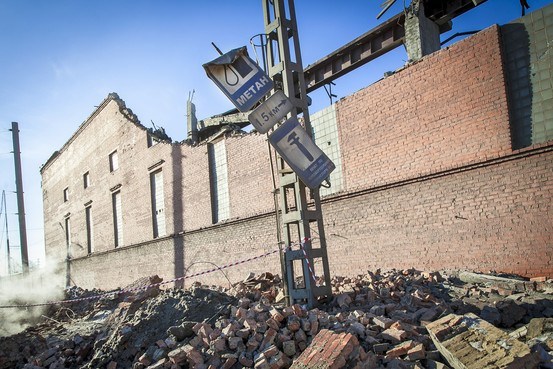Many are not held back about being strident. Why should not intellectuals do the same? After all, what they do is most important. So Nietzsche was strident, for example against German racist, anti-Semite, mediocre nationalistic, herd like aspiring bourgeois. Apparently that was not strident enough, and, somehow, the Nazis succeeded to make many believe that their worst enemy (Nietzsche) was their prophet.
The herd approves of those who are peaceful. So, to be taken seriously by the herd, to be a bovine intellectual, so to speak, one needs to be for peace, against conflict and anything violent. In particular, nuclear power, you know, from the nuclei which are all over matter, is not kosher.
The wall of a zinc plant in Chelyabinsk, Russia, was damaged by a shockwave from the meteor exploding 40 kilometers away, in 2013. With a mass of around 10,000 tons, 50% more than the Eiffel Tower, its explosion at 30 kilometers altitude damaged 7,200 buildings in 6 cities, injuring 1,500 people. Just a warning. It was the fiercest impact known since the Tunguska event. That destroyed 80 million trees in a radius of around 30 kilometers. Yet left not even a fleck of dust we know of. But there may have been others over the oceans, or even. Amazonia in the 1930s, where an object brighter than the sun impacted!
A 100 meters across asteroid would explode with around 100 Megatons of TNT energy, around double the largest nuclear device ever exploded (the notorious “Czar Bomba”; see the picture inside “The Worst”)
For years would-be wise men, in scientist clothing claimed that nuclear weapons would not be efficient against asteroids. That was obviously an idiotic, and even dangerous position to have. in most plausible scenarios of a bolide impact, we would have little warning. A typical case is that of a comet on an hyperbolic trajectory, falling at enormous speed from the Oort Cloud.
Such bolides are attracted by planets like flies to honey. After all, gravitation is not called “universal attraction” for no good reason.
One such comets is going to graze Mars. It may as well have headed straight to Earth.
And then what?
Nukes. Big, fat, thermonuclear nukes.
Indeed, soft options then don’t work. Forget “gravity tractor” and “impactor.” The former involves using gravitational tug from a large spaceship to tweak an asteroid’s course. The impactor would crash at high speed into the asteroid to effect the same purpose. both may well fail, as asteroid are bizarrely constituted. Some are little more than rubble piles.
Soft methods would only work if the asteroid were small enough and seen soon enough. Many, as the one above, come from the Sun’s direction, so cannot be seen from Earth, as they catch up with her.
For large objects, short response times, or a comet, a nuclear explosion “is the only option,” (said, for asteroids, Bong Wie, a professor and director of Iowa State University’s Asteroid Deflection Research Center).
I wrote entire essays on this in the past. Now I am happy to announce that this point of view has been heard.
Some U.S. nuclear-warhead components, scheduled for disassembly, have gotten a new lease on life. Reason: possible use in defending the Earth against killer asteroids, or comets.
The National Nuclear Security Administration manages the U.S. atomic-weapons arsenal. The warhead components, containing highly enriched uranium, are being retained “pending a senior-level government evaluation of their use in planetary defense against earthbound asteroids,” an April 2014 report reveals.
Asteroids with a diameter of about a kilometer or bigger, could “produce global devastation,” said the National Research Council in 2010. Hundreds cross Earth’s orbit, yet none are expected to impact for at least 100 years.
Yet an estimated 100,000 or more asteroids at least 50 meters in diameter pass through Earth’s orbit. ” Probably no more than 5% of these “Near-Earth Objects” have been detected. A 50 meter asteroid exploding over a large city could kill up to 30 million people.
Those beasts tend to explode in the atmosphere, leaving no material remnants, as happened in Tunguska. So the statistics we have about how frequently they come knocking, are suspect.
It’s a world of forces, a violent world, out there. Better be ready.
When flying a civilization, we have to assume that, if it may happen, it will happen. Especially if it’s very catastrophic. That’s the essence of Catastrophic Calculus, fundamental to flying planes, and civilizations.
Patrice Ayme






